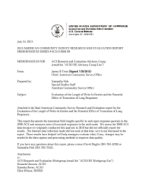Evaluation of the Length of Write-In Entries and the Potential Effect of Truncation of Long Responses
Evaluation of the Length of Write-In Entries and the Potential Effect of Truncation of Long Responses
Starting in mid-2007, the American Community Survey (ACS) began using Optical Mark Recognition (OMR) and key-from-image (KFI) software to capture data from returned paper questionnaires. Keyers recorded respondent data directly from scanned computer images of the returned forms instead of finding and flipping through them physically. The adoption of this new software provided ACS the opportunity to capture more characters for write-in entries on the mail forms. For the first time, keyers could enter respondent write-ins up to a very large maximum length.
However, many subsequent coding operations truncate these data before coders view them because the coding software requires certain input lengths, which we cannot easily change. To assess whether we should spend time and resources to make changes, the ACS archived the "before and after" truncation values for all write-in entries. The ACS program planned to use these files to measure how often truncation occurs. This would help management decide if expanding field lengths for write-in entries in the coding software is worth the cost to make the changes.
Additionally, the ACS collects data in the Computer Assisted Telephone Interviewing (CATI) and Computer Assisted Personal Interviewing (CAPI) modes. CATI and CAPI interviewers use computer instruments to collect respondent data, which have various field sizes for open responses. Interviewers may abbreviate input into the instrument when the maximum field length is too small for a response. Although no truncation occurs in the subsequent coding of these responses, the ACS seeks to find out how often CATI and CAPI open responses meet maximum input lengths in the CATI and CAPI instruments.
This report documents the maximum field lengths specific to each open response question in the 2009 ACS, measures rates of truncation in the mail mode, and summarizes the distributions of response lengths in the mail and automated modes. Results of this research help evaluate what, if any, changes may be needed in the data capture and processing methods to improve data quality.
Others in Series
Working Paper
Working Paper
Working Paper




